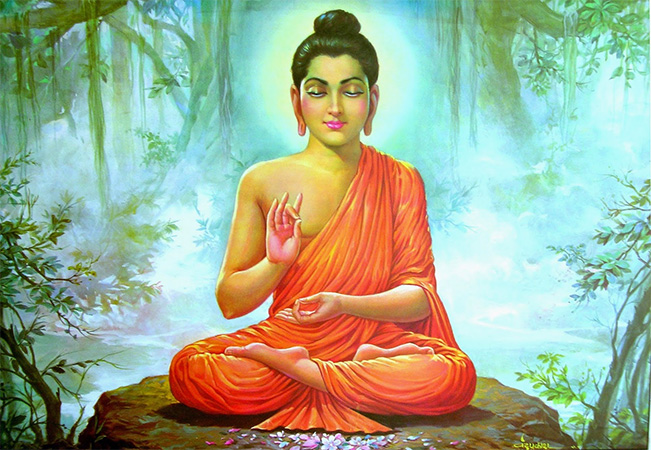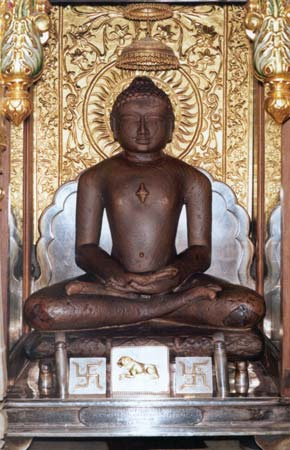History of Jainism
Jainism is an independent and an ancient religion of India with a recorded history dating back to 3500-3000 BCE. Jainas consider their religion as eternal and imperishable, without a beginning or an end, an Universal History describing just one tiny portion of an eternal process. For the outsiders however, there is another kind of Jain history. Constructed by scholars and historians, this one tries to separate the fact from the fiction.
Discovery of seals from the Indus Valley Civilization has thrown a new light on the antiquity of Jainism. Nude figures considered to be that of the first Jain Tirthankara, Rishabhdev has been discovered on the seals found at Mohenjodaro and Harappa. The findings point towards the representation of the seventh Tirthankara Suparshvanath and the fact that the people of the Indus Valley not only practiced Yoga but also worshipped the images of Yogis. Figures in Kayotsarga posture are peculiarly Jain.
Additionally the sacred sign of Swastika is also found engraved on a number of seals. Furthermore, some motifs on the seals found at Mohenjodaro are identical to those found in the ancient Jain art of Mathura. Thus, the fact that Jainism has a long and rich antiquity is established without a doubt.

Jainism in Vedic Period
The Rig Veda has many portions with clear references to Rishabhdev, the first Tirthankar as well as Aristanemi, the 22nd Tirthankara. The Yajur Veda also mentions the names of three Tirthankar - Rishabhdev, Ajitnath and Aristanemi. Furthermore, the Atharva Veda mentions the sect of Vratya meaning the observer of vratas or vows as distinguished from the Hindus of those times. Also in Atharva Veda, the term “Maha Vratya” occurs in reference to Rishabha Dev who was considered as a great leader of the vratyas.
It is also claimed at times that Jainism has been in existence even before the first Vedas were written. Rigveda also talks about Vaman Avatar, the 15th incarnation amongst the 24 incarnation. Rishabhdev’s name comes across as the 9th incarnation Vishnu. Rishabhas name occurs before Vaman, Krishna, and Buddha incarnations. Therefore, Rishabhdev must have flourished long before the composition of Rigveda. The great scholar Dr. S. Radhakrishnan, ex-president of Indian Union, in his India Philosophy had observed, "Jain tradition ascribes the origin of the system to Rishabhdev, the first Tirthankara. There is no doubt that Jainism prevailed even before Parasvanath. The Bhagwat Puran endorses the view that Rishabhadeva was the founder of Jainism.
The research of the renowned Jain scholar, Prof. A. Chakravarty have brought to light priceless material which prove the ancient nature of Jain thought. Critical study of some Vedic Hymns like Nadsiya Sukta point to the fact that there must have been a peculiar current of thought existing in the pre-Vedic period which influenced the Vedas. Dr. Mangaldev feels that "Jain Philosophy might be a branch of the pre-Vedic current of thoughts.” Thus, this establishes the fact that Jainism preceded even the Vedic culture.

Jainism in Buddha Period
Mahavira was was a senior contemporary of Gautama Buddha, the founder of Buddhism. In Buddhist texts, Lord Mahavir is always described as Nigantha Nataputta (Nigrantha Jnatraputra) i.e. the naked ascetic of the Jnatra clan. Buddhist literature also refers to Jainism as an ancient religion. There are ample references in Buddhist literature to the naked Jain ascetics, to the worship of Arhats in Jain chaityas or temples and to the chaturyama dharma (i.e. fourfold religion) of the 23rd Tirthankar Parsvanath.
The Buddhist texts also refers to the Jain tradition of Tirthankaras and specifically mentions the names of Jain Tirthankaras like Rishabhdev, Padmaprabh, Chandraprabh, Puspdant, Vimalnath, Dharmanath and Neminath. The Buddhist book Manorathapurani mentions the names of many lay men and women as followers of the Parsvanath tradition. Among them is the name of Vappa, the uncle of Gautama Buddha. In face, it is mentioned that Gautama Buddha himself practiced penance according to the Jain way before he propounded his new religion.
In the Buddhist scripture, Majjima Nikaya, Buddha himself tells us about his ascetic life and its ordinances which are in conformity with the Jain monks’ code of conduct. He says, "Thus far, SariPutta did I go in my penance. I went without clothes. I licked my food from my hands. I took no food that was brought or meant especially for me. I accepted no invitation to a meal." Mrs. Rhys Davis has observed that Buddha found his two teachers Alara and Uddaka at Vaishali and started his religious life as a Jaina.
Jain Tirthankaras
Neminath or Aristanemi who preceded Lord Parshvanath, was a cousin of Krishna. He was a son of Samudravijaya and grandson of Andhakavrsni of Sauryapura. Krishna had negotiated the wedding of Neminath with Rajimati, the daughter of Ugrasena of Dvaraka. Neminath attained emancipation on the summit of Mount Raivata (Girnar). There is a mention of Neminath in several vedic canonical books. The king named Nebuchadnazzar was living in the 10th century B.C. It indicates that even in the tenth century B.C. there was the worship of the temple of Neminath.

The historicity of Lord Parshvanath has been unanimously accepted. He preceded Lord Mahavir by 250 years. He was the son of King Asvasena and Queen Vama of Varanasi. At the age of thirty he renounced the world and became an ascetic. He practiced austerities for eighty three days. On the eighty fourth day he obtained omniscience. Lord Parshvanath preached his doctrines for seventy years. At the age of one hundred he attained liberation on the summit of Mount Sammd (Parsnath Hills). The four vows preached by Lord Parshvanath are not to kill, not to lie, not to steal, and not to own property.
Lord Mahavira was the twenty fourth, i.e., the last Tirthankaras. According to the tradition of the Shvetambar Jains the Nirvan of Lord Mahavira took place 470 years before the beginning of the Vikrama Era. The tradition of the Digambar Jains maintains that Lord Mahavira attained Nirvan 605 years before the beginning of the Saka Era. By either mode of calculation the date comes to 527 B.C. Since the Lord attained emancipation at the age of 72, his birth must have been around 599 B.C. This makes Lord Mahavira slightly elder contemporary of Buddha who probably lived about 567-487 B.C. Lord Mahavira was the head of an excellent community of 14,000 monks, 36,000 nuns, 159,00O male lay votaries and 318,OOO female lay votaries. The four groups designated as monks, nuns, laymen and laywomen constitute the four fold order (tirtha) of Jainism.
Of the eleven principle disciples (Ganadharas) of Lord Mahavir, only two, viz., Gautam Swami and Sudharma Swami survived him. After twenty years of Nirvan of Lord Mahavira, Sudharma Swami also attained emancipation. He was the last of the eleven gandharas to die. Jambu Swami, the last omniscient, was his pupil. He attained salvation after sixty four years of the Nirvan of Lord Mahavira.
There were both types of monks, viz., Sachelaka (with clothes) and Achelaka (without clothes), in the order of Lord Mahavir. Both types of these groups were present together up to several centuries after Lord Mahavira attained Nirvana.
Conclusion
Thus, to conclude, Jainism is a religion steeped in rich history. With roots going back to thousands of years, it is one of the most formidable and peaceful religion in the world that has survived through time to show its followers a new path.
